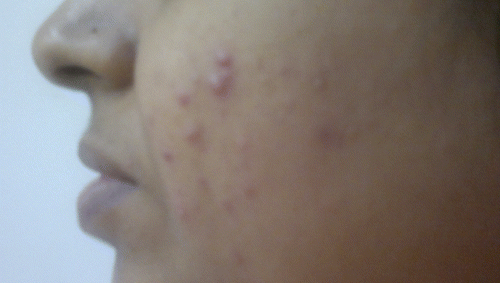Sertraline-Induced Acneiform Eruption
To the Editor: Sertraline is a specific serotonin reuptake inhibitor (SSRI) antidepressant, which is uncommonly associated with adverse cutaneous drug reactions such as rash, pruritus, dermatitis, purpura, urticaria, and rarely, Steven-Johnson syndrome.1 The summary of product characteristics (SPC) for sertraline shows acneiform eruptions is associated infrequently with sertraline.2 A PUBMED search did not reveal any report of such association in English literature. We report a case of paranoid schizophrenia patient who developed acneiform lesions after treatment with sertraline 50 mg/day for depressive symptoms, and it subsided within 5 days of discontinuation of the drug.
Case Report
A 38-year-old woman, diagnosed with paranoid schizophrenia, was on maintenance risperidone 8 mg/day along with topiramate 50 mg/day for migraine. There were no active psychotic symptoms. Her birth and developmental history were unremarkable. One paternal cousin brother had history of psychosis. She presented with recent onset depressive disorder for which sertraline 50 mg/day was started. After 12 days, she developed acneiform lesions over her face, which was distressing to the patient (Figure 1). There was no past history of acne or other dermatological disorder. Investigations including complete blood count, renal and liver function tests, blood sugar, and lipid profile were normal. Based on Naranjo adverse drug reaction probability scale3 score of 5, a probable diagnosis of sertraline-induced acneiform eruption was considered. Following discontinuation of sertraline, acneiform lesions disappeared over 5 days without any other intervention.

Discussion
Characteristics of drug-induced acne include sudden onset (within days), monomorphic lesions (papules and pustules in same stage), and development of inflammatory papules prior to comedones, an unusual location of the lesions beyond the seborrheic areas, an unusual age of onset, a resistance to conventional acne therapy and, recent drug introduction.4 Several drugs have been associated with the development of acneiform eruptions including corticosteroids, anticonvulsants, antipsychotics, antidepressants, lithium, antituberculosis drugs, and immunomodulating molecules.5 There is one case report of acneiform eruptions associated with escitalopram.6
Acne may be related to sertraline-induced high activity in the serotonergic system at the dermal and epidermo-dermal junctional area.7 In our case, acne subsided following discontinuation of sertraline within a week, though severe lesions may take several weeks to resolve and may require topical therapy. Although uncommon, drug-induced acneiform eruptions need to be identified early, specifically in young female patients to ensure medication compliance.
1 : Cutaneous effects of the most commonly used antidepressant medication, the selective serotonin reuptake inhibitors. J Am Acad Dermatol 2007; 56:848–853Crossref, Medline, Google Scholar
2 Summary of product characteristics. Zoloft: prescribing information. Available at: http://labeling.pfizer.com/ShowLabeling.aspx?id=517. Accessed May 22, 2013Google Scholar
3 : A method for estimating the probability of adverse drug reactions. Clin Pharmacol Ther 1981; 30:239–245Crossref, Medline, Google Scholar
4 : Drug-induced acneiform eruption. Am J Clin Dermatol 2011; 12:233–245Crossref, Medline, Google Scholar
5 : A status report on drug-associated acne and acneiform eruptions. J Drugs Dermatol 2010; 9:627–636Medline, Google Scholar
6 : Escitalopram oxalate (Lexapro)-induced acneiform eruption. J Am Acad Dermatol 2012; 67:e261–e263Crossref, Medline, Google Scholar
7 : Itch and skin rash from chocolate during fluoxetine and sertraline treatment: case report. BMC Psychiatry 2004; 4:36Crossref, Medline, Google Scholar



